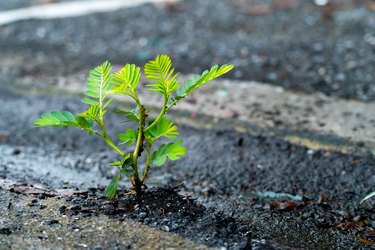
Glucose is the primary sugar found in a person's blood and is a human being's main energy source. It mostly comes from foods rich in carbohydrates, like bread, fruit and potatoes. Once a person consumes the food, the body's enzymes and acids break it into pieces, and glucose is released. It heads to the intestines and then into the bloodstream. Insulin then helps the glucose get to the cells.
Where does glucose come from, and how is it produced? Plants produce glucose through the process of photosynthesis. For a plant to go through this, it needs energy from the sun, a source of carbon dioxide and access to water.
Video of the Day
Video of the Day
Plants and Photosynthesis
Plants make food through the process of photosynthesis. It all starts when they trap light energy with their leaves and absorb carbon dioxide and water from the air and soil. Inside plant cells, the water oxidizes, the carbon dioxide gets reduced and it gains electrons. This reaction changes the water into oxygen and carbon dioxide into glucose. The oxygen gets released into the air, and glucose molecules store the energy.
This energy is then used by plants to grow, thrive and make other substances, like starch and cellulose. Plant parts and seeds store starch as a food source, and these plants use cellulose to build cell walls. Certain foods, like grains and rice, have a lot of starch in them. To break this process down into simpler terms, photosynthesis uses oxygen from sunlight, carbon dioxide and water through a long series of chemical reactions to create glucose, a simple sugar.
Not all forms of photosynthesis are the same, though. The one used by most plants is called C3, and it produces a three-carbon compound known as 3-phosphoglyceric acid that eventually becomes glucose. The type of photosynthesis a plant develops depends on the resources available in its environment. For example, C4 photosynthesis produces more carbon and lets plants do well in places that do not have as much water or light.
What Is Chlorophyll?
The majority of plants in the world contain chlorophyll, a specially colored pigment or colored chemical that the plant needs for photosynthesis. This chlorophyll actually absorbs energy from the sun and converts it into chemical energy. It absorbs blue and red light from the sun and reflects green light, which results in the leaves looking green. Once plants stop producing chlorophyll, the leaves change color as we see in the fall.
You can find chlorophyll in a plant's chloroplasts, which are minuscule structures within plant cells. This nutrient is found in exceptionally high quantities in plant-based foods, like green zucchini and broccoli. The greener a specific food, the more chlorophyll it likely contains. The two types of chlorophyll are called chlorophyll a and chlorophyll b, and all plants have one or both. Both of the different types of chlorophyll are fat-soluble compounds, and they also have antioxidant properties.
Can the Human Body Make Glucose?
The liver stores glucose, acting as a reservoir that helps keep the circulating blood sugar levels and other bodily fuels consistent and constant. It also manufactures glucose depending on what the body needs. The need to store and release glucose is mainly regulated by two hormones known as glucagon and insulin.
When you eat food, elevated levels of insulin and lower (suppressed) levels of glucagon promote glucose storage, and it stays in the liver as glycogen until it is needed. The liver turns glycogen into glucose through the process of glycogenolysis. It can also manufacture needed glucose and sugar by harvesting fat byproducts, amino acids and bodily waste products.
That means that the human body does make glucose but not out of nowhere. Instead, the human body ends up keeping the earlier forms of glucose in the body, eventually turning those into the actual glucose product when it needs more.